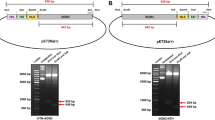Abstract
The insulin-like growth factor (IGF-I) gene (GenBank accession no. AY247412) of Qiantang River triangular bream (Megalobrama terminalis) was cloned for the first time from the liver by reverse transcriptase polymerase chain reaction. The gene was inserted into pMD 18-T vector to construct the recombinant plasmid pMD 18-T/IGF-I. Sequence analysis indicated that the IGF-I cDNA consisted of 486 nucleotides encoding 161 amino acids, which spanned the complete signal peptide, mature peptide (including B, C, A, and D domains), and E-domain. Analysis of the E domain indicated that triangular bream IGF-I gene belonged to the IGF-I Ea-2 subtype. To construct the expression plasmid, the IGF-I gene was subcloned into prokaryotic expressing vector pGEX-4T-1. The recombinant plasmid pGEX-4T-1/IGF-I was transformed into Escherichia coli BL21 (DE3), and the transgene expression was observed after being induced with isopropylthiogalactoside. The results of sodium dodecyl sulfate polyacrylamide gel electrophoresis (SDS-PAGE) and Western blotting indicated that the recombinant fusion protein had immune activity, and the molecular weight was about 47 kDa. The results of SDS-PAGE and thin-layer scanning showed that the yield of fusion protein had been enlarged with prolonging time. When the time of induced expression was 1, 2, 3, 4, 5, and 6 h, the expression amount was approximately 1.4, 4.3, 8.1, 11.3, 16.3, and 18.8% of total bacterial protein, respectively.





Similar content being viewed by others
References
Uchida, K., Kajimura, S., Riley, L. G., et al. (2003). Comparative Biochemistry and Physiology. Part A, Physiology, 134, 429–439.
Castillo, J., Codina, M., Martinez, M. L., et al. (2004). American Journal of Physiology. Regulatory, Integrative and Comparative Physiology, 286(5), R935–R941.
Cao, Q. P., Duguay, S. J., Plisetskaya, E., et al. (1989). Molecular Endocrinology, 3(13), 2005–2010.
Shamblott, M. J., & Chen, T. T. (1993). Molecular Marine Biology and Biotechnology, 2, 351–361.
McRory, J. E., Sherwood, N. M. (1994). Journal of Biological Chemistry, 269(28), 18588–18592.
Duguay, S. J., Chu, S. J., Mommsen, T. P., et al. (1995). FEBS Letters, 371(1), 69–72.
Duguay, S. J., Zhang, L. J., Steiner, D. F., et al. (1996). Journal of Molecular Endocrinology, 16, 123–132.
Dominique, L. C., Annette, C. S., Hannes, G., et al. (1998). Molecular and Cellular Endocrinology, 141(1), 187–194.
Kermouni, A., Mahmoud, S. S., Wang, S., et al. (1998). General and Comparative Endocrinology, 111(1), 51–60.
Minoru, T., Tomomi, T., Ichiro, Y., et al. (1998). DNA and Cell Biology, 17(10), 859–868.
Chen, J.-Y., Chen, J.-C., Chang, C.-Y., et al. (2000). Aquaculture, 181(3–4), 347–360.
Bai, J. J., Lao, H. H., Ye, X., Li, Y. H., et al. (2001). Zoological Research, 22(6), 502–506.
Hua, Y. M., & Lin, H. R. (2001). Acta Zoologica Sinica, 47(3), 274–279.
Marures, T., Chan, S. J., Xu, B., Sun, H. S., et al. (2002). Endocrinology, 143(5), 1858–1871.
Queenie, P. V., Chan, K. M., Kin, L., et al. (2003). Gene, 322, 145–156.
Li, S. F., Zhu, Z. W., Zou, S. M., et al. (2002). Acta Zoologica Sinica, 48(3), 339–345.
Hanahan, D. (1985). Techniques for transformation of E. coli. DNA cloning (pp. 109–135). Oxford: IRL Press.
Srivastava, P., & Deb, J. K. (2002). FEMS Microbiology Letters, 212(2), 209–216.
Acknowledgements
This project was supported by Zhejiang Provincial Natural Science Foundation of China (No. 300265).
Author information
Authors and Affiliations
Corresponding author
Rights and permissions
About this article
Cite this article
Zhang, H., Tong, FD. & Lu, QE. Cloning of Qiantang River Triangular Bream (Megalobrama terminalis) IGF-I Gene and Expression of the Recombinant pre-IGF-I in Escherichia coli . Appl Biochem Biotechnol 150, 15–24 (2008). https://doi.org/10.1007/s12010-007-8027-9
Received:
Accepted:
Published:
Issue Date:
DOI: https://doi.org/10.1007/s12010-007-8027-9




